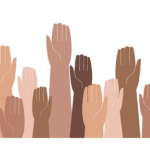Do the very training programs aiming to help us understand minority groups better actually promote stereotypes more? Are we actually offending different ethnic groups?
Yet hundreds of studies dating back
Anthropology Now, 10:48–55, 2018
to the 1930s suggest that anti-bias
training doesn’t reduce bias, alter
behavior, or change the workplace.
In my workplace, we work hard to provide resources to staff with a goal of creating an inclusive environment. Diversity training and culture-specific training, of course, are part of this effort. Are we falling short of the goal? Are we even running on the right track? In an article published in the Journal of Business and Psychology, the authors concluded that “recent research has demonstrated that diversity training methods, if not framed appropriately, can actually lead to increases in both implicit and explicit expressions of prejudice.” 1
Throughout the article the authors evaluated different diversity training methods and their effectiveness. They review three main methods of diversity training: perspective talking, goal setting, and stereotype discrediting. Overall, the findings reported by Lindsey et al. seemed to support the notion that the results, positive or negative, depend on the method used to teach about diversity training, as well as individual characteristics of the recipient. Lindsey et al. concluded that perspective talking seemed to be the most successful method for diversity training, but an individual’s level of empathy greatly impacted the results as well.1
Of course this is one study amongst a sea of studies on the topic. After reading many of them, I have come up, in my own experience, with the same conclusion that they have. You just can’t force people to not be biased. Maybe, our own sense of free will reels against being forced to accept things we actually don’t really believe. Forced training can actually make things worse!
So I have a list of characteristics generally seen in patients of Mexican descent who access healthcare services. Does that list help me? Does it limit my ability to look beyond the list as I’m working with patients? That isn’t a black and white (no pun) answer for me. I think it helps me by giving me a starting point for observations I might be experiencing, a framework for questions to ask. But we can’t teach empathy. The only way for me to understand my mexican patient population is to spend time with them. The only way to reduce biases is to increase the empathy of the person who holds the bias. Perhaps our diversity training needs to always include exposure to those we believe are different.
1. Lindsey A, King E, Hebl M, Levine N. The impact of method, motivation, and empathy on
diversity training effectiveness. J Bus Psychol. 2015;30(3):605-617.
